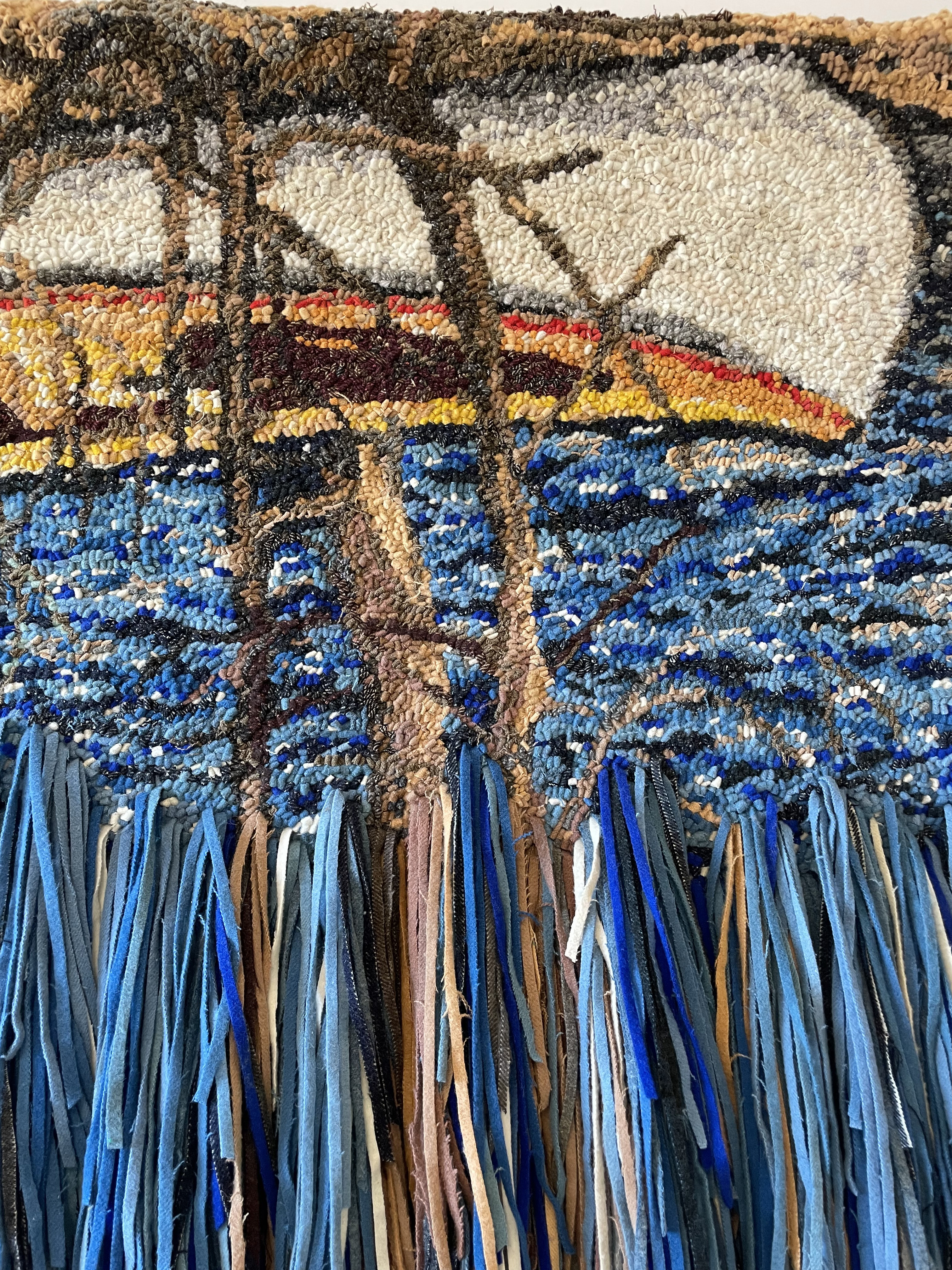2022
Hudson Bay Blankets in original colours, burlap
8.5’ x 7.7’





spill: after Tom Thomson’s The Canoe is part of a series of large-scale textile/installation works that depict reconfigured versions of Group of Seven and Tom Thomson paintings. Made from deconstructed Hudson Bay Company point blankets and RCMP blankets, this series extends my practice of manipulating iconic forms of Canadian visual and material culture and my ongoing engagement with the Truth and Reconciliation Commission of Canada’s Call to Action 46:ii, which appeals for the “repudiation of concepts used to justify European [Canadian] sovereignty over Indigenous lands and peoples.”[1]Bringing these two components of my work together, this series disrupts colonial conceptions of land, landscape, and “Canadian” sovereignty and identity with a view towards movements of decolonial change and noncolonial relations. By manipulating commonplace “Canadiana” using rug hooking as a domestic textile technique, I situate the critical re-imaginings in this series within the everyday as a site where beliefs tied to colonial whiteness are often both surreptitiously and overtly perpetuated as “narration(s) of truth.”[2]
Mythologies propagated by early Canadian landscape painters have deeply influenced understandings of land, sovereignty and emplacement in Canadian society. By metaphorically transforming Indigenous land into Canadian landscape, their works helped to entrench concepts of colonial sovereignty and whiteness, and Indigenous dispossession referred to in Call 46:ii, while cultivating a “quasi-official image of Canadian national identity”[3]through a colonial lens that endures to the present. For example, their portrayal of land as empty reinforced the colonial concept of terra nullius and their assertion of a deep connection between Canadian-ness and wilderness embedded a sense of state/settler entitlement to Indigenous lands. Further, Group members such as Lawren Harris produced writings that extol whiteness as an inherent and desirable characteristic of the Canada state.
The works in this series reimagine iconic landscape paintings using HBC point blankets as powerful Canadian symbols with fraught histories. The HBC is linked to the project of settler colonial nation-building through its activities during the fur trade and beyond. It spearheaded colonial practices of resource exploitation and is enmeshed in systems of land theft that epitomize the imposition of colonial sovereignty. HBC blankets can be seen as the first colonial currency in what was to become Canada. They are understood to have been used to spread disease among Indigenous peoples, yet they also came to have a strong presence in some Indigenous communities. In “mainstream” Canadian society HBC blankets have long been seen as national icons and luxury items with their complex histories largely being overwritten. The implications of the HBC and its blankets, however, are in no way static. In Sept 2022, increasing acknowledgement of these difficult histories led the HBC to announce that all proceeds from the sale of its point blankets will be used to support Indigenous cultural, artistic and educational activities through Oshki Wupoowane (The Blanket Fund). By aligning with contemporary moves towards reconciliation, this development, along with other recent gestures on the part of the HBC, add to the narratives of the blankets and their parallels with Canadian society. The tangled lineage and ongoing story of the HBC point blanket makes it a resonant material to deconstruct and reconfigure in this work as a way of counter-storying dominant Canadian mythologies and contesting landscape traditions that celebrate the entitlement of settler colonial whiteness.
The first work in the series is spill: after Tom Thomson’s The Canoe which is a reinterpretation of Tom Thomson’s painting The Canoe is made entirely from HBC point blankets in their original colours. The image is not only scaled up to twelve times the size of the original painting, it is turned upside down so that the titular canoe hovers among tangles of small trees at the top of the work. Below the inverted canoe, the rug hooked waters give way to shreds of blanket material that form a deconstructed version of the landscape imagery of the remainder of the painting giving the impression of the landscape spilling out or the piece being at the same time in the process of construction and dismantling.
As in previous worksI approach the canoe as an appropriated form of Indigenous technology that demonstrates the colonizer’s appetite for extraction. Historically, the canoe is tied to the consumptive tide of trade, resource exploitation, and territorial expansion that exemplifies settler colonial dis/possession. In contemporary terms, the canoe has been instrumentalized as a defining feature of national identity further tying Canadian-ness to wilderness and settler Canadians to the land. By manipulating Tom Thompson’s version of the canoe in this work, I aim to disturb its appropriation into Canadian life as well as its connotations of settler belonging.
︎ ︎
[1] Truth and Reconciliation Commission of Canada Calls to Action p 5.
[2] Audra Simpson, “Whither Settler Colonialism?,” Settler Colonial Studies 6, no. 4 (2016): 444.
[3]O'Brian, J. (2007). Beyond wilderness: The group of seven, Canadian identity, and contemporary art. McGill-Queen's Press-MQUP, p 13.
Produced with the assistance of the Manitoba Arts Council and the Winnipeg